投资学第七章
- 格式:pptx
- 大小:559.62 KB
- 文档页数:35
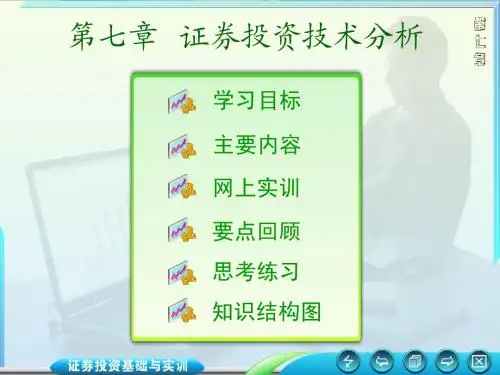
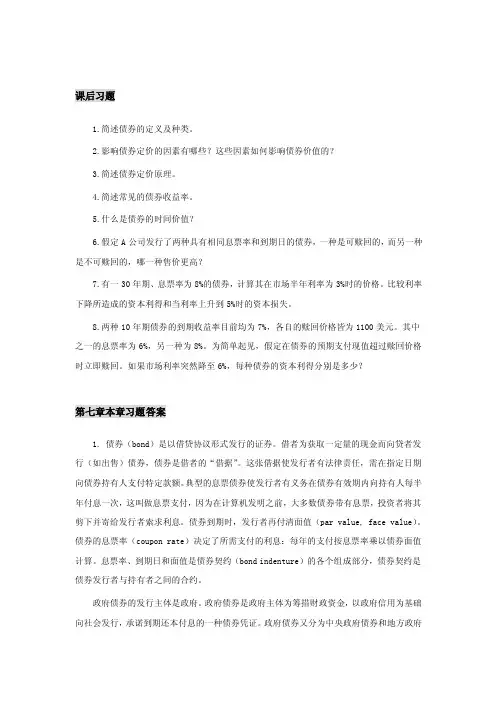
课后习题1.简述债券的定义及种类。
2.影响债券定价的因素有哪些?这些因素如何影响债券价值的?3.简述债券定价原理。
4.简述常见的债券收益率。
5.什么是债券的时间价值?6.假定A公司发行了两种具有相同息票率和到期日的债券,一种是可赎回的,而另一种是不可赎回的,哪一种售价更高?7.有一30年期、息票率为8%的债券,计算其在市场半年利率为3%时的价格。
比较利率下降所造成的资本利得和当利率上升到5%时的资本损失。
8.两种10年期债券的到期收益率目前均为7%,各自的赎回价格皆为1100美元。
其中之一的息票率为6%,另一种为8%。
为简单起见,假定在债券的预期支付现值超过赎回价格时立即赎回。
如果市场利率突然降至6%,每种债券的资本利得分别是多少?第七章本章习题答案1. 债券(bond)是以借贷协议形式发行的证券。
借者为获取一定量的现金而向贷者发行(如出售)债券,债券是借者的“借据”。
这张借据使发行者有法律责任,需在指定日期向债券持有人支付特定款额。
典型的息票债券使发行者有义务在债券有效期内向持有人每半年付息一次,这叫做息票支付,因为在计算机发明之前,大多数债券带有息票,投资者将其剪下并寄给发行者索求利息。
债券到期时,发行者再付清面值(par value, face value)。
债券的息票率(coupon rate)决定了所需支付的利息:每年的支付按息票率乘以债券面值计算。
息票率、到期日和面值是债券契约(bond indenture)的各个组成部分,债券契约是债券发行者与持有者之间的合约。
政府债券的发行主体是政府。
政府债券是政府主体为筹措财政资金,以政府信用为基础向社会发行,承诺到期还本付息的一种债券凭证。
政府债券又分为中央政府债券和地方政府债券。
中央政府债券又称为国债。
公司债券,是公司按照法定程序发行,约定在一定期限内还本付息的债权债务凭证。
公司债券代表着发债的公司和投资者之间的一种债权债务关系。
债券持有人是公司的债权人, 不是所有者,无权参与或干涉公司经营管理,但债券持有人有权按期收回本息。
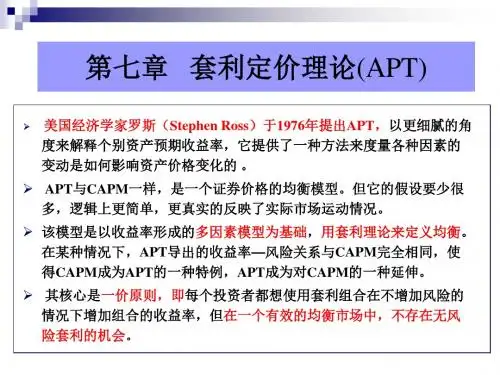
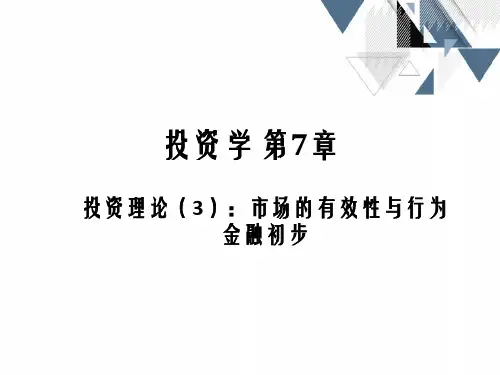
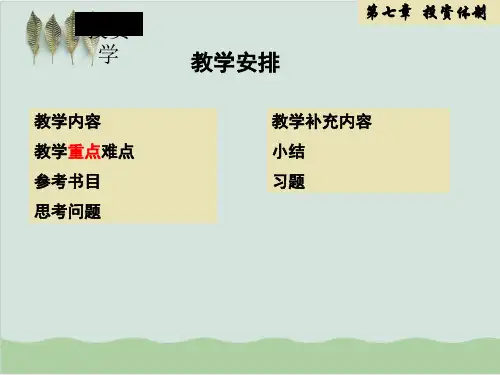


第七章证券交易市场一、思考题1. 简述证券交易市场与证券发行市场的关系。
(1)证券交易市场对证券发行市场具有依赖性(2)证券交易市场促进了证券发行市场的发展2. 证券上市的概念、条件与意义。
(1)证券上市又称交易上市,是指已公开发行的证券经过证券交易所批准在交易所内公开挂牌买卖。
(2)各国证券法对证券上市的条件规定不同,但基本标准大致相同,通常包括上市公司的资本额、资本结构、赢利能力、偿债能力、股权分散状况、公司财务情况、开业时间等。
(3)证券上市的意义重大。
对于发行人来说,证券上市提高了证券的流通性和变现力,解决了发行人追求资金的长期稳定性和投资人希望证券的及时获利性的矛盾,为短期资金加入长期证券投资提供了可能,扩大了发行人的筹资来源。
证券上市后,也可提高发行人的知名度,扩大发行人的市场地位和影响力。
此外,证券价格的变动,可形成对公司业绩的一种市场评价机制。
这迫使发行人建立规范的法人治理结构,努力经营,为投资者提供理想的回报。
对于投资者而言,证券上市提供了一个连续的、便利的、低成本的买卖证券的可能,发行人持续信息披露为投资者决策提供了依据。
3. 证券交易所有哪两种类型?(1)公司制证券交易所(2)会员制证券交易所4. 比较证券场内交易方式与场外交易方式的利与弊。
场内交易:又称交易所交易,指所有的供求方集中在交易所进行竞价交易的交易方式。
这种交易方式具有交易所向交易参与者收取保证金、同时负责进行清算和承担履约担保责任的特点。
场外交易:又称柜台买卖或称店头市场,英文简称为 OTC (Over-The-Counter)。
有价证券不在集中市场上以竞价的方式买卖,而在证券商的营业柜台以议价的方式进行的交易行为,称作场外交易。
由柜台买卖所形成的市场,称为场外交易市场。
场外交易市场是一种松散的、没有买卖集中地点的市场,交易由为数众多的交易商和经纪商用电话、电报或电传进行。
美国场外交易市场买卖的证券,既有在证券交易所挂牌上市的证券,也有未挂牌上市的证券。
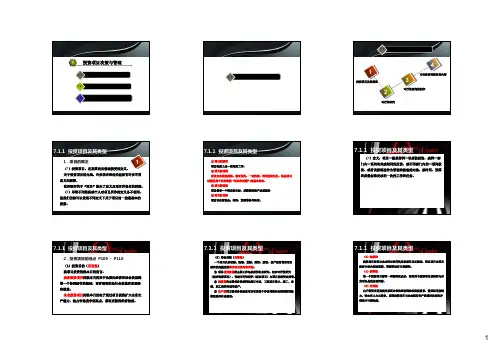
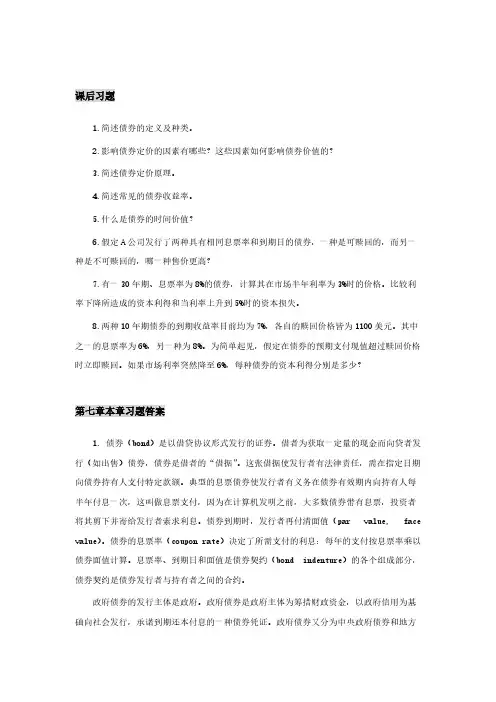
课后习题1.简述债券的定义及种类。
2.影响债券定价的因素有哪些?这些因素如何影响债券价值的?3.简述债券定价原理。
4.简述常见的债券收益率。
5.什么是债券的时间价值?6.假定A公司发行了两种具有相同息票率和到期日的债券,一种是可赎回的,而另一种是不可赎回的,哪一种售价更高?7.有一30年期、息票率为8%的债券,计算其在市场半年利率为3%时的价格。
比较利率下降所造成的资本利得和当利率上升到5%时的资本损失。
8.两种10年期债券的到期收益率目前均为7%,各自的赎回价格皆为1100美元。
其中之一的息票率为6%,另一种为8%。
为简单起见,假定在债券的预期支付现值超过赎回价格时立即赎回。
如果市场利率突然降至6%,每种债券的资本利得分别是多少?第七章本章习题答案1. 债券(bond)是以借贷协议形式发行的证券。
借者为获取一定量的现金而向贷者发行(如出售)债券,债券是借者的“借据”。
这张借据使发行者有法律责任,需在指定日期向债券持有人支付特定款额。
典型的息票债券使发行者有义务在债券有效期内向持有人每半年付息一次,这叫做息票支付,因为在计算机发明之前,大多数债券带有息票,投资者将其剪下并寄给发行者索求利息。
债券到期时,发行者再付清面值(par value, face value)。
债券的息票率(coupon rate)决定了所需支付的利息:每年的支付按息票率乘以债券面值计算。
息票率、到期日和面值是债券契约(bond indenture)的各个组成部分,债券契约是债券发行者与持有者之间的合约。
政府债券的发行主体是政府。
政府债券是政府主体为筹措财政资金,以政府信用为基础向社会发行,承诺到期还本付息的一种债券凭证。
政府债券又分为中央政府债券和地方政府债券。
中央政府债券又称为国债。
公司债券,是公司按照法定程序发行,约定在一定期限内还本付息的债权债务凭证。
公司债券代表着发债的公司和投资者之间的一种债权债务关系。
债券持有人是公司的债权人, 不是所有者,无权参与或干涉公司经营管理,但债券持有人有权按期收回本息。
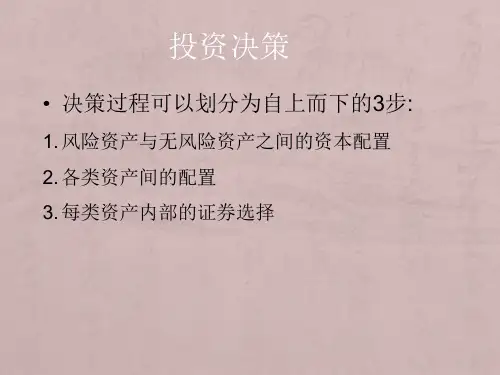

1. Because very few securities will exhibit perfectly positive correlation,diversification will tend to reduce portfolio risk. Thus, for any given level of expected return, one would expect that portfolios will exhibit lower risk (lie further to the west in the feasible set) than individual portfolios (which will therefore lie to the east in the feasible set).2. Diversified portfolios are more efficient than individual securities. That is,diversified portfolios provide the investor with higher expected returns for given levels of risk and/or lower risk for given levels of expected return when compared with individual securities.Diagrammatically, individual securities will lie in the eastern portion of the feasible set. Hence they are dominated by diversified portfolios, which lie in the northwestern portion of the feasible set, including those on the efficient set.3. The macroeconomic forces that impact the U.S. economy tend to have a strongeffect on the earnings (and, hence, stock prices) of all domestic corporations, although the magnitude of this effect will vary among industries and specific firms.For example, a recession causes most companies to experience a downturn in earnings. While some companies may be more severely affected than others, nevertheless, the broad influence of a recession on general economic activity likely results in most companies' stocks performing poorly.Companies whose stocks would be expected to have a high positive covariance are auto and steel companies. When auto sales are strong (weak), the demand for steel generally rises (falls). The earnings of companies in both industries would rise and fall at roughly the same time and this movement would likely be anticipated by the earlier rise and fall of their stocks' prices.Companies whose stocks would be expected to have a low covariance are banks and gold mining firms. Rising interest rates and poor business conditions generally produce declining bank earnings. At the same time, a pessimistic economic outlook often causes investors to increase their demand for gold, which increases the price of gold and, therefore, the earnings of gold mining firms. The result is that the stock prices of banks and gold mining firms will not likely move in the same direction.4. It is the fact that all stocks do not have high positive covariances that causesdiversification to benefit the investor. That is, by diversifying, investors can reduce portfolio risk and thereby create more efficient portfolios. If stocks did have high positive covariances, then holding a well-diversified portfolio would not result in meaningful reductions in risk relative to holding individual securities.5. If the security in question had significant negative correlation with the rest of thesecurities in the portfolio, Mule might consider purchasing it even though it had anegative expected return. The diversifying nature of the security might reduce the risk of the portfolio sufficiently to make it attractive despite its inferior return potential.6. Given the expected returns and variance-covariance estimates for all securities, aninvestor can construct the efficient set. This information, combined with the unique risk-return preferences of the investor, allows the investor to determine his or her optimal portfolio. Diagrammatically, this optimal portfolio lies at the point of tangency between the investor's indifference curves and the efficient set.7. The standard deviation of a two-security portfolio is given by:[]σσσρσσp A A B B A B AB A B X X X X =++22122/In Dode's case:= [(.35)²(20)² + (.65)²(25)² + 2(.35)(.65)(20)(25)12]½= [49 + 264 + 22812]½The portfolio's standard deviation will be at a minimum when the correlation between securities A and B is -1.0. That is:= [49 + 264 - 228]½= 9.2%The portfolio's standard deviation will be at a maximum when the correlation between securities A and B is +1.0. That is: = [49 + 264 + 228]½= 23.3%17. The beta of a portfolio is defined as the weighted average of the componentsecurities' betas. In the case of Siggy's portfolio:ββP i i i X ==∑13= (.30 ⨯ 1.20) + (.50 ⨯ 1.05) + (.20 ⨯ 0.90)= 1.07Further, the standard deviation of a portfolio can be expressed as:()σβσσεp P I p =+22212/= [(1.07)²(18)² + (.30)²(5.0)² +(.50)²(8.0)²+ (.20)²(2.0)²]½= [370.9 + 2.3 + 16.0 + 0.2]½= [389.4]½ = 19.7%18.The total risk of a portfolio can be expressed as: σβσσεp p I p =+222Further, the unique risk (σεp 2) is the weighted average of the unique risks of the portfolio's individual securities. In the case of the first portfolio with four equal-weighted securities:()()σεp i 2221430025=⨯=∑..= 56.25 ⨯ 4 = 225.0Therefore the total risk of the first portfolio is:0.225)20()00.1(2221+⨯=σ= 625.01 = 25.0%In the case of the second portfolio with ten equal-weighted securities:()()σεp i 22211030010=⨯=∑..= 9.0 ⨯ 10 = 90.0Therefore the total risk of the second portfolio is:σ222210020900=⨯+(.)().= 490.02 = 22.1%。